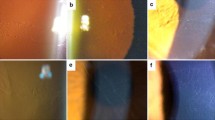Abstract
Background
Deposits in the cornea and lens are a known complication of long-term chlorpromazine therapy.
Method
A 59-year-old woman had previously taken chlorpromazine for 20 years with doses up to 1,200 mg/day, with a mean dose of 400 mg/day. She presented with gradual onset of blurred vision in her left eye. Slit-lamp biomicroscopy revealed multiple fine creamy-white deposits on her corneal endothelium and anterior crystalline lens capsule bilaterally.
Results
In vivo confocal microscopy of the cornea identified irregular hyper-reflective deposits on the posterior surface of the endothelium. The deposits varied from 1 μm to 70 μm in diameter and had well-defined edges. Endothelial morphology was otherwise normal bilaterally.
Conclusions
This is the first report of in vivo confocal imaging of deposits resulting from long-term chlorpromazine use. Microstructural analysis of the corneal endothelium reveals that there were no abnormalities in cellular morphology resulting from these deposits.


Similar content being viewed by others
References
Brooks AM, Grant G, Gillies WE (1992) Specular microscopy in the identification of deep corneal opacities. Surv Ophthalmol 36(5):351–356
Deluise VP, Flynn JT (1981) Asymmetric anterior segment changes induced by chlorpromazine. Ann Ophthalmol 13(8):953–955
Forrest IS, Carr J, Usdin E (1974) Phenothiazines and structurally related drugs. Raven, New York, pp 290–292
Grupcheva CN, Craig JP, Sherwin T, McGhee CN (2001) Differential diagnosis of corneal oedema assisted by in vivo confocal microscopy. Clin Exp Ophthalmol 29(3):133–137
Hollister LE (1995) Katzung BG (ed) Basic and clinical pharmacology, 6th edn. Appleton and Lange, Connecticut (440 pp)
Webber SK, Domniz Y, Sutton GL et al (2001) Corneal deposition after high-dose chlorpromazine hydrochloride therapy. Cornea 20(2):217–219
Wolf ME, Richer S, Berk MA, Mosnaim AD (1993) Cutaneous and ocular changes associated with the use of chlorpromazine. Int J Clin Pharmacol Ther Toxicol 31(8):365–367
Author information
Authors and Affiliations
Corresponding author
Rights and permissions
About this article
Cite this article
Phua, Y.S., Patel, D.V. & McGhee, C.N.J. In vivo confocal microstructural analysis of corneal endothelial changes in a patient on long-term chlorpromazine therapy. Graefe's Arch Clin Exp Ophthalmol 243, 721–723 (2005). https://doi.org/10.1007/s00417-004-0982-z
Received:
Revised:
Accepted:
Published:
Issue Date:
DOI: https://doi.org/10.1007/s00417-004-0982-z




